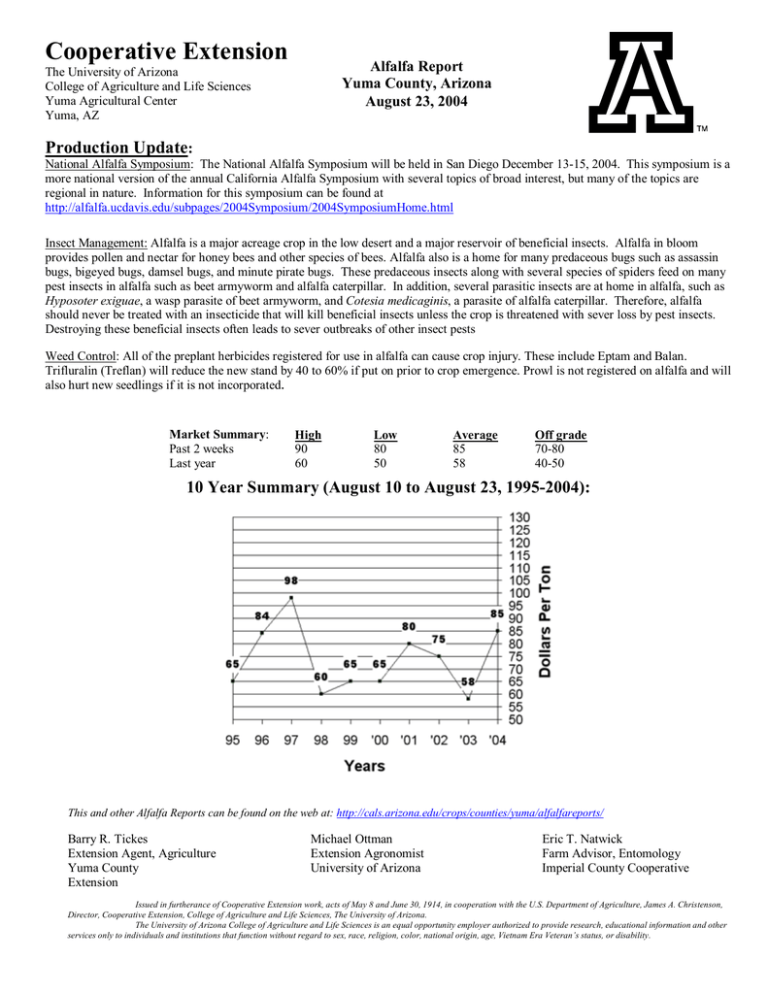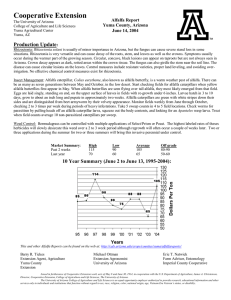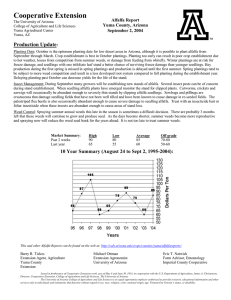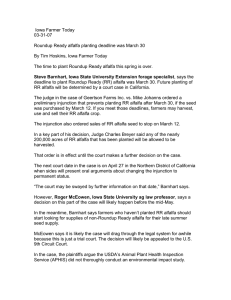Cooperative Extension Production Update :
advertisement

Cooperative Extension Alfalfa Report Yuma County, Arizona August 23, 2004 The University of Arizona College of Agriculture and Life Sciences Yuma Agricultural Center Yuma, AZ Production Update: National Alfalfa Symposium: The National Alfalfa Symposium will be held in San Diego December 13-15, 2004. This symposium is a more national version of the annual California Alfalfa Symposium with several topics of broad interest, but many of the topics are regional in nature. Information for this symposium can be found at http://alfalfa.ucdavis.edu/subpages/2004Symposium/2004SymposiumHome.html Insect Management: Alfalfa is a major acreage crop in the low desert and a major reservoir of beneficial insects. Alfalfa in bloom provides pollen and nectar for honey bees and other species of bees. Alfalfa also is a home for many predaceous bugs such as assassin bugs, bigeyed bugs, damsel bugs, and minute pirate bugs. These predaceous insects along with several species of spiders feed on many pest insects in alfalfa such as beet armyworm and alfalfa caterpillar. In addition, several parasitic insects are at home in alfalfa, such as Hyposoter exiguae, a wasp parasite of beet armyworm, and Cotesia medicaginis, a parasite of alfalfa caterpillar. Therefore, alfalfa should never be treated with an insecticide that will kill beneficial insects unless the crop is threatened with sever loss by pest insects. Destroying these beneficial insects often leads to sever outbreaks of other insect pests Weed Control: All of the preplant herbicides registered for use in alfalfa can cause crop injury. These include Eptam and Balan. Trifluralin (Treflan) will reduce the new stand by 40 to 60% if put on prior to crop emergence. Prowl is not registered on alfalfa and will also hurt new seedlings if it is not incorporated. Market Summary: Past 2 weeks Last year High 90 60 Low 80 50 Average 85 58 Off grade 70-80 40-50 10 Year Summary (August 10 to August 23, 1995-2004): This and other Alfalfa Reports can be found on the web at: http://cals.arizona.edu/crops/counties/yuma/alfalfareports/ Barry R. Tickes Extension Agent, Agriculture Yuma County Extension Michael Ottman Extension Agronomist University of Arizona Eric T. Natwick Farm Advisor, Entomology Imperial County Cooperative Issued in furtherance of Cooperative Extension work, acts of May 8 and June 30, 1914, in cooperation with the U.S. Department of Agriculture, James A. Christenson, Director, Cooperative Extension, College of Agriculture and Life Sciences, The University of Arizona. The University of Arizona College of Agriculture and Life Sciences is an equal opportunity employer authorized to provide research, educational information and other services only to individuals and institutions that function without regard to sex, race, religion, color, national origin, age, Vietnam Era Veteran’s status, or disability.




